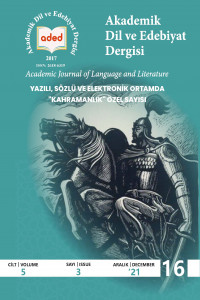Abstract
İnsanoğlunun en büyük merakı olan ölümden sonraki hayat, birçok din ve kültürde benzer motiflerle tasvir edilmiştir. Dinî metinler dışında, insan ruhunun gideceği yer ve dünyadaki davranışlarına göre ölüm sonrası yaşayacaklarının belirlenmesi üzerine tarih boyunca birçok edebî eser kaleme alınmıştır. Çalışmada insanın hangi dine ya da hangi kültürel daireye mensup olursa olsun ürettiği ve inandığı şeyin ortaklığı vurgulanmış, İlahi Komedya ile Altay Destanı Maaday Kara karşılaştırılmıştır. Dante’nin İlahi Komedya’sı bugüne kadar birçok farklı eserle karşılaştırılarak incelenmiştir. İlahi Komedya’da öte dünyaya olan yolculuğunun ilk seyahati olan Cehennem, dokuz kattan oluşmakta ve bu katlar günahlara göre sıralanmaktadır. Altay Destanı Maaday Kara ise ölümle savaşan ve onu yenen kahraman Kögüdey Mergen’in ölümü yenmesi için cehenneme yaptığı yolculuğu anlatmaktadır. Bu yolculukta görülmektedir ki cehennem dokuz katlıdır ve katlar günahlara göre sıralanmaktadır. Bu çalışmanın amacı iki eserin öte dünyayla ilgili motiflerini tespit ederek insanlığın ortak algısında bulunan cehennem kavramını incelemektir. Her iki eser de kahramanını cehennemde yolculuğa çıkarır ve insanlığın ortak cehennem ve günah algısını ortaya koyar. Farklı inançlara ve dönemlere ait olmalarına rağmen insanlığın öteki yaşamla ilgili sorularının cevaplarını vermesi bakımından benzer olan bu eserler, ait olduğu topluma hayatı nasıl yaşaması gerektiğini öğütleyen yol gösterici nitelikte ürünlerdir.
References
- Balaci, A.(1969). Dante Alighieri. Bucarest: Pentru Literatura.
- Bekki, S. (2007). Maaday Kara Destanı. Elazığ: Manas Yayıncılık.
- Dante, A. (1999). İlahi Komedya. Çev. Rekin Teksoy. İstanbul: Oğlak yayınevi.
- Dilek, İ. (2010). Sibirya Türk Destanlarında Kahramanın Yeraltı ve Gökyüzü Dünyalarıyla İlişkileri Üzerine Bazı Tespitler. Millî Folklor, S.22, ss.85.
- Ekici, M. (2007). Halk Bilgisi Derleme ve İnceleme Yöntemleri. Ankara: Geleneksel yayınları.
- Guénon, R. (2014). Dante ve Ortaçağ’da Dinî Sembolizm. Çev. İsmail Taşpınar, İstanbul: İnsan Yayınları.
- Gürsoy Naskali, E. (2015). Altay Destanı Maaday Kara. İstanbul: Yapı Kredi Yayınları.
- Korkmaz, Ö. (2001). Dante Alighieri-Yaşamı ve Eserleri. Dokuz Eylül Üniversitesi Sosyal Bilimler Enstitüsü Dergisi. Cilt 3, Sayı:2, ss.46-93.
- Ögel, B. (1995). Türk Mitolojisi (Kaynakları ve Açıklamaları ile Destanlar). II. Cilt, Ankara: Türk Tarih Kurumu yayınları.
- Öncel, S.(1997). İtalyan Edebiyatı Tarihi. Ankara: İtalyan Kültür Heyeti.
- Temel, Ö. P. (2016). İlahi Komedya: XXVIII-XXXIII-XXXIV Sayılı Kantolarla Dante'nin" Cehennem" inde Adalet Kavramı ve" Contrapasso" Yasası. Ankara Üniversitesi Dil ve Tarih-Coğrafya Fakültesi Dergisi, 56(1).
- Uğurcan, F. Z. (2016). Altay Destanları Üzerine Bir İnceleme -Yaratılış, Yaşam, Öte Dünya. Yüksek Lisans Tezi, Yıldız Teknik Üniversitesi, İstanbul.
- Yaşar, İ. Ö. (2009). Kıbrıs Türk Edebiyatında İtalyan Şâiri Dante. Electronic Turkish Studies, 4(8).
The Hero's Journey to Hell: The Depiction of Hell in The Altai Epic Maaday Kara and The Divine Comedy
Abstract
Llife after death, which is the biggest curiosity of humankind, has been figured by similar motifs in many religions and cultures. Many literary works have been written about the place where the human soul will go and the determination of what the human will live according to behaviours on earth after-life, not only religious texts. Divine Comedy, the most famous one without a doubt in these works, has been compared and analyzed with many different works and has been emphasized the common points on what humans believed and produced regardless of which religion or what cultural circle a human belongs to. Hell, Dante’s first journey to the afterworld, consisted of nine layers, and these layers lined up according to the sins. Altai Epic Maaday Kara, another work we analyzed, is about the journey to hell to defeat the death, of the protagonist Kögüdey Mergen’s battles with death and his victory. In this journey, it has been seen that hell consisted of nine layers and these layers lined up according to the sins. The aim of this study is to examine the concept of hell, which is in the common perception of humanity by determining the motifs of both works about the afterlife. Both works take their hero on a journey through hell and reveal humanity's common perception of hell and sin. Although they belong to different beliefs and periods, these works, which are similar in terms of giving answers to humanity's questions about the next life, are guiding products that advise the society they belong to how to live life.
References
- Balaci, A.(1969). Dante Alighieri. Bucarest: Pentru Literatura.
- Bekki, S. (2007). Maaday Kara Destanı. Elazığ: Manas Yayıncılık.
- Dante, A. (1999). İlahi Komedya. Çev. Rekin Teksoy. İstanbul: Oğlak yayınevi.
- Dilek, İ. (2010). Sibirya Türk Destanlarında Kahramanın Yeraltı ve Gökyüzü Dünyalarıyla İlişkileri Üzerine Bazı Tespitler. Millî Folklor, S.22, ss.85.
- Ekici, M. (2007). Halk Bilgisi Derleme ve İnceleme Yöntemleri. Ankara: Geleneksel yayınları.
- Guénon, R. (2014). Dante ve Ortaçağ’da Dinî Sembolizm. Çev. İsmail Taşpınar, İstanbul: İnsan Yayınları.
- Gürsoy Naskali, E. (2015). Altay Destanı Maaday Kara. İstanbul: Yapı Kredi Yayınları.
- Korkmaz, Ö. (2001). Dante Alighieri-Yaşamı ve Eserleri. Dokuz Eylül Üniversitesi Sosyal Bilimler Enstitüsü Dergisi. Cilt 3, Sayı:2, ss.46-93.
- Ögel, B. (1995). Türk Mitolojisi (Kaynakları ve Açıklamaları ile Destanlar). II. Cilt, Ankara: Türk Tarih Kurumu yayınları.
- Öncel, S.(1997). İtalyan Edebiyatı Tarihi. Ankara: İtalyan Kültür Heyeti.
- Temel, Ö. P. (2016). İlahi Komedya: XXVIII-XXXIII-XXXIV Sayılı Kantolarla Dante'nin" Cehennem" inde Adalet Kavramı ve" Contrapasso" Yasası. Ankara Üniversitesi Dil ve Tarih-Coğrafya Fakültesi Dergisi, 56(1).
- Uğurcan, F. Z. (2016). Altay Destanları Üzerine Bir İnceleme -Yaratılış, Yaşam, Öte Dünya. Yüksek Lisans Tezi, Yıldız Teknik Üniversitesi, İstanbul.
- Yaşar, İ. Ö. (2009). Kıbrıs Türk Edebiyatında İtalyan Şâiri Dante. Electronic Turkish Studies, 4(8).
Details
| Primary Language | Turkish |
|---|---|
| Subjects | Literary Studies |
| Journal Section | Articles |
| Authors | |
| Publication Date | November 30, 2021 |
| Submission Date | September 22, 2021 |
| Acceptance Date | October 31, 2021 |
| Published in Issue | Year 2021 Volume: 5 Issue: 3 |

